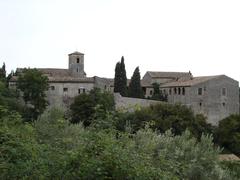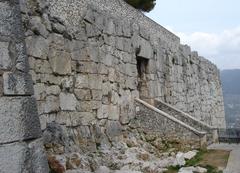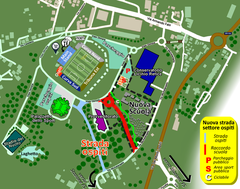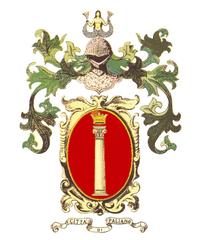
Guide to Visiting Via Collemassaro, Frosinone, Italy
Date: 01/08/2024
Introduction
Via Collemassaro in Frosinone, Italy, is not merely a street; it is a passage through time that reveals a fascinating blend of historical, cultural, and natural wonders. Located in the heart of the Lazio region, Frosinone boasts a rich history that dates back to its origins as an ancient Volsci settlement and later as a significant Roman colony. This guide aims to provide an in-depth exploration of Via Collemassaro, offering insights into its historical background, visitor information, and nearby attractions. Whether you are a history enthusiast, an architecture aficionado, or a nature lover, this guide will help you make the most of your visit to Frosinone. For more detailed historical context, you can refer to Britannica and FamilySearch.
Table of Contents
- Introduction
- Historical Background
- Visitor Information
- Travel Tips and Nearby Attractions
- Cultural Significance and Heritage
- Genealogical and Archival Resources
- Architectural Highlights
- Natural and Archaeological Sites
- Conclusion
- FAQ
Historical Background
Ancient Origins and Roman Influence
Via Collemassaro is situated in Frosinone, a city with a rich historical tapestry that dates back to ancient times. Originally known as Frusino, Frosinone was a significant settlement of the Volsci people, an ancient Italic tribe. The city later became a Roman colony, which is evident from the remnants of ancient walls and a Roman amphitheater that still stand today (Britannica).
Medieval Turmoil and Renaissance Revival
Following the fall of the Western Roman Empire, Frosinone experienced numerous invasions and destructions. The city was repeatedly ravaged by foreign invaders, including German, Florentine, and French troops during the Sack of Rome in 1527. In 1556, Spanish troops also caused significant damage (FamilySearch). Despite these challenges, Frosinone managed to rebuild and thrive. By the Renaissance period, the city had begun to recover, with new architectural and cultural developments marking its revival.
Modern Era and World War II
The modern era brought both growth and hardship to Frosinone. The city’s population expanded significantly from around 2,000 people in the mid-17th century to over 10,000 by the time of Italy’s unification in the late 19th century (FamilySearch). In 1927, the Fascist government designated Frosinone as the capital of a new province, incorporating territories from the provinces of Caserta and Rome. World War II had a profound impact on Frosinone, leading to extensive damage from bombings.
Post-War Reconstruction and Modern Development
Post-war reconstruction efforts transformed Frosinone into a blend of ancient and modern elements. The Cathedral of Santa Maria Assunta, with its Romanesque bell tower, and the Abbey Church of St. Benedict, rebuilt in the Baroque style, are prime examples of this blend (Understanding Italy). Modern development includes the establishment of green spaces such as Il Parco dei Nonni and Giardino dei Cinque Sensi.
Visitor Information
Visiting Hours and Tickets
- Cathedral of Santa Maria Assunta: Open daily from 9 am to 6 pm. Entry is free.
- Abbey Church of St. Benedict: Open daily from 8 am to 7 pm. Entry is free.
- Parks: Open daily from dawn to dusk. Entry is free.
Accessibility
Most historical sites in Frosinone, including Via Collemassaro, are accessible to visitors with mobility impairments. The parks and major religious sites have ramps and accessible pathways.
Travel Tips and Nearby Attractions
Travel Tips
- Footwear: Wear comfortable walking shoes as the area has cobblestone streets.
- Hydration: Carry a water bottle, especially during the summer months.
Nearby Attractions
- Piazza della Libertà
- Palazzo della Provincia
- Natural park of Terme Varroniane
Cultural Significance and Heritage
Frosinone is the heart of the Ciociaria district, known for its traditional peasant costumes and rich cultural heritage. The city’s historical and cultural significance is preserved in its numerous churches, monuments, and public squares.
Genealogical and Archival Resources
For those interested in genealogical research, Frosinone offers a wealth of resources. The State Archives of Frosinone and the Anagni-Guarcino section hold extensive civil registry files, including birth, marriage, and death records from 1809 to 1945 (Antenati).
Architectural Highlights
Frosinone’s architectural landscape is a testament to its historical evolution. The Pietro Tiravanti building, designed by Edgardo Vivoli, is one of the first in Italy to use anti-seismic reinforced concrete (Understanding Italy).
Natural and Archaeological Sites
Frosinone’s natural and archaeological sites add to its allure. The Rocca Janula, a castle overlooking the city, and the remains of a Roman theater are notable historical landmarks. The natural park of Terme Varroniane, with its mineral springs, offers a serene escape into nature (Understanding Italy).
Conclusion
Via Collemassaro in Frosinone offers a unique blend of history, culture, and natural beauty. From ancient Roman influences to modern architectural marvels, visitors will find a wealth of experiences that make for a memorable visit. Don’t forget to explore the scenic parks and delve into your genealogical roots.
FAQ
- Q: What are the visiting hours for major sites in Frosinone?
- A: Most sites are open daily from 9 am to 6 pm.
- Q: Are there any entry fees?
- A: Entry to most historical sites and parks is free.
- Q: Is Frosinone accessible for visitors with mobility impairments?
- A: Yes, most sites have accessible pathways and ramps.
Call to Action
Download the mobile app Audiala to explore more about Frosinone, check out other related posts on our website, and follow us on social media for the latest updates.
References
- Britannica, n.d., https://www.britannica.com/place/Frosinone-Italy
- FamilySearch, n.d., https://www.familysearch.org/en/wiki/Frosinone,_Lazio,_Italy_Genealogy
- Understanding Italy, n.d., https://www.understandingitaly.com/frosinone-province.html
- Antenati, n.d., https://antenati.cultura.gov.it/archivio/state-archives-of-frosinone/?lang=en




